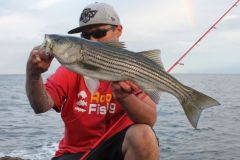How to identify rocky plateaus?
A rocky plateau, as the name suggests, is a more or less vast area of rock with a relatively flat profile. They can be found at the edges and offshore, and are all the more interesting as they contrast with the majority substrates in the area.
There are several very simple ways to identify them, whether you're an angler on foot or on a boat.
- In shallow areas close to the shore, aerial photo sites make it easy to locate rocky plateaus. They will appear as a dark spot in the middle of a lighter area (sand).
- Outings at low tide during high coefficients are also an excellent way for shore anglers to identify suitable areas in their sector and locate the edge flats that are then uncovered.
- On bathymetric charts, you can locate rocky plateaus by geometric shapes materialized by a succession of moderately to widely spaced sounding lines in the middle of a zone of constant and greater depth.
- Finally, on bathymetric charts, but also on the datashom website, for example, substrate types are indicated by color or letters, enabling you to locate the most promising spots.

Why prospect rocky plateaus?
Rocky plateaus are often excellent areas for bass fishing, as they concentrate a great diversity of marine species and are therefore good food spots. You'll find plenty of crustaceans, especially crabs and bouquets, which bass love, as well as numerous small rock fish such as crenilabra and gobies. Sea bass aren't the only feeders, however, and they'll also find cephalopods and shoals of forage feeding on worms or micro-organisms tossed about by the swell.

Which rocky plateaus to fish for bass?
Of course, not all plateaus are the same, and not all bars are open at the same time. The best ones meet different criteria:
- The presence of a current if possible.
- Exposure to swell for those located shallow or on the edge.
- A varied relief made up of couloirs and rock heads.
- The presence of vegetation, whether kelp or seaweed.
- Its isolation over a vast area.
- Alternating substrates.

How do you approach them?
For shelves swept by the current, it's ideal to start prospecting or drifting upstream, since depending on the tide and coefficient, bass (and pollack) may be positioned primarily on the upstream section, which will accelerate the current and concentrate the food. However, sea bass, especially when schooling and active, like to navigate on the plateau, and it will be possible to find them at mid-water level positioned all along the plateau.
Still in the middle of the plateau, you can also hook fish posted near the bottom behind a rock, or kelp sheltered from the current and the sight of prey, so it's worth marking the points where you can hook a posted bass.
The downstream end of the plateau is often of interest when the current is very strong, as bass like to rest there and ambush prey as it rushes downstream.
Finally, outsides can also hold fish, especially if the tray is set in the middle of the sand and its sides are marked, once again allowing the sea bass to shelter from the current and surprise their prey.

Techniques and lures for bass fishing?
Rocky plateaus are excellent positions for bass anglers, as their expanse allows for long drifts and casts and therefore does not require precise boat placement or targeting of a specific water vein.
But their strength lies in the fact that they can be exploited with all modern sea bass fishing techniques.
When the fish are active, give priority to hard lures, stickbaits and minnows in the lead, then prospect deeper on the fly with slugs or in linear or pull patterns.
Finally, if the fish seem to be less active and settled on the bottom, scratch fishing or rather "downhill" fishing by fine-tuning your weights will bring you the most bites.
On this type of position, you'll obviously find schools of forage fish, such as sprats and sardines, but when fishing close to the bottom I recommend brown colors, which are closer to the prey assessed on the rock.
Report summary
1
Fishing spots: look for open-water hunting for sea bass
2
Finding the right spots for bass fishing: prospecting for wrecks
3
The best spots for sea bass fishing: fringe meadows
4
Sea bass fishing spots: rocky coasts from shore and by boat
5
Finding the right spots for bass fishing: rocky plateaus
6
Sea bass spots: the unmissable, fruitful rock heads
7
Good bar spots: focus on emerging rocks and foam
8
Good spots for bass fishing: rocky points
9
Good spots for bass fishing: oyster beds
10
The best spots for bass fishing: prospect for mouths
11

 /
/ 

















